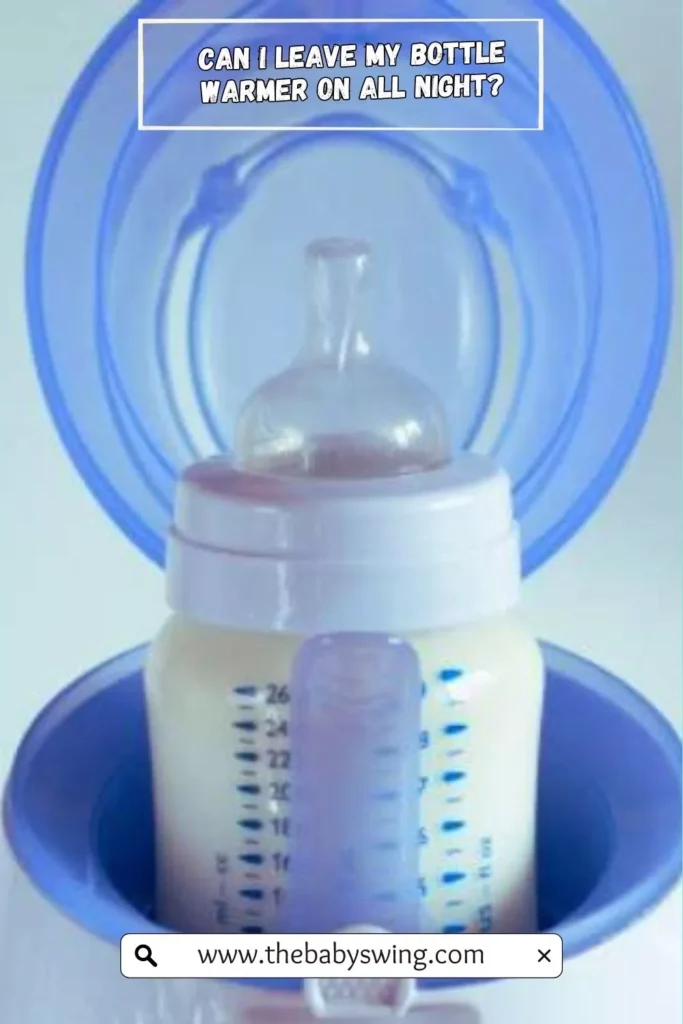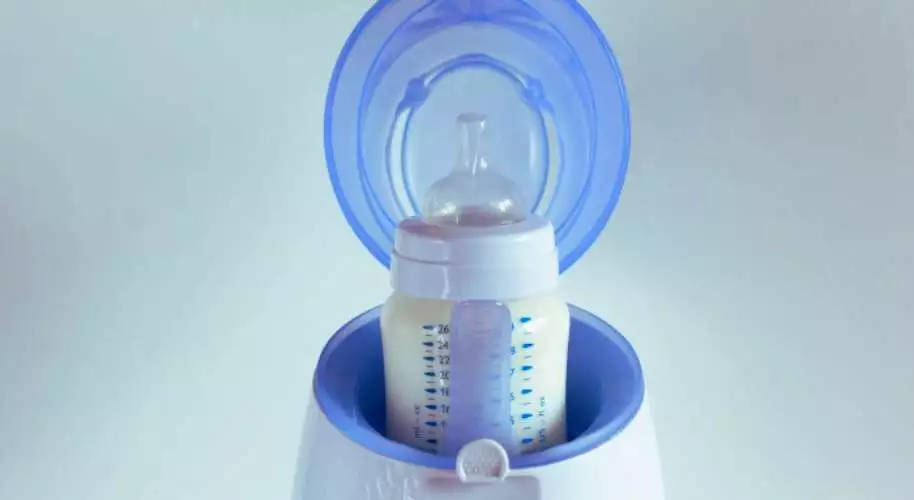Last Updated on June 5, 2025
When it comes to the safety and comfort of our little ones, every parent wants to ensure they’re doing the best they can. One common question, particularly for new parents navigating the world of baby care gadgets, is: “Can I leave my bottle warmer on all night?”
The short answer is no. For several reasons, leaving a bottle warmer on throughout the night is not recommended.
Safety is paramount, and any device that generates heat poses a potential risk if left unattended for extended periods. Moreover, prolonged heating can degrade the milk’s nutritional quality and may pose a risk of bacteria growth.

Can I leave my bottle warmer on all night?
Regarding the question, “Can I leave my bottle warmer on all night?” the consensus among experts is a resounding no. The reasons for this are multifaceted, encompassing both safety concerns and health considerations.
Dr. Rebekah Diamond, a pediatric hospitalist and assistant professor of pediatrics at Columbia University, warns against leaving a bottle in a warmer due to the risk of food poisoning. The temperature inside a bottle warmer is the ideal breeding ground for bacteria. She also explains that leaving a bottle warmer on all night could lead to overheating, which poses a fire risk.
For how long is it safe to leave a bottle in a bottle warmer?
Bottle warmers are convenient for parents, making it easier to heat baby’s milk to the perfect temperature. However, a common question arises: “For how long is it safe to leave a bottle in a bottle warmer?”
The answer varies depending on the type of bottle warmer and the specific instructions the manufacturer provides. Rebecca Novak, a New-York based registered dietitian, recommended not to leave a bottle in the warmer for more than 10 minutes.
Extended heating can cause the milk to overheat, which not only risks burning your baby’s mouth but could also degrade the nutritional quality of the milk. Leaving the bottle warmer on for an extended period poses a safety risk.
What are the steps to effectively use a bottle warmer?
Using a bottle warmer might seem straightforward, but there are specific steps you should follow to ensure it’s done safely and effectively. Here’s a step-by-step guide:
Read the Manual:
Every bottle warmer is different, so familiarizing yourself with your specific model is important by reading the manual.
Clean the Bottle Warmer:
Before using it, make sure the bottle warmer is clean. This will prevent any bacterial growth that could harm your baby.
Fill With Water:
Most bottle warmers use steam to heat the bottle. Fill the warmer with the recommended amount of water.
Place the Bottle in the Warmer:
Ensure the bottle is closed properly, then place it in the warmer.
Set the Timer:
The time it takes to warm the bottle will depend on several factors, including the initial temperature of the milk, the quantity of milk, and the type and size of the bottle. Start by following the manufacturer’s guidelines and adjust as necessary.
Start the Warmer:
Turn on the bottle warmer. Some models may have an indicator light to show when the bottle is ready.
Check the Temperature:
Before feeding your baby, always check the milk temperature by shaking the bottle and placing a few drops on your wrist. It should feel warm, not hot.
Clean After Use:
After each use, clean the bottle warmer according to the manufacturer’s instructions. This is crucial to maintain hygiene and prolong the life of the device.
You Might Also Like These Resources!
- Baby Swing Weight & Age Limit Guidelines
- Can Baby Swings Cause Shaken Baby Syndrome Or Brain Damage?
- How long can baby be in graco swing
What are the ways to keep a baby’s bottle warm during the night?

Keeping a baby’s bottle warm during the night can be challenging, especially when minimizing disruptions to your little one’s sleep schedule. Here are some ways to ensure that your baby’s milk is at the right temperature, even in the middle of the night:
- Bottle Insulators:
These are specially designed covers that keep the bottle warm for extended periods. They work similarly to thermoses, trapping the heat inside.
- Thermal Bags:
These portable bags can keep a pre-warmed bottle warm for several hours. Just make sure the bottle is sealed tightly to avoid leaks.
- Hot Water Flask:
Keep a flask of hot water in the baby’s room. When it’s time for feeding, pour the hot water into a bowl and place the bottle in it for a few minutes.
- Electric Bottle Warmer:
While leaving a bottle warmer on all night is not recommended, you could use one with an auto shut-off feature. Warm the bottle before your baby wakes up for a feed.
- Room Temperature Bottles:
If your baby doesn’t mind, you could prepare formula or express breast milk and store it at room temperature. According to CDC, freshly prepared formulas can be used within two hours if kept at room temperature.
- Refrigerator and Warm Water:
Store prepared bottles in the refrigerator, and when it’s feeding time, warm them in a bowl of warm water.
How can I keep a baby’s bottle warm while on the move?
Keeping a baby’s bottle warm while moving can be challenging but not impossible. Here are some practical tips and tricks to ensure your baby’s milk stays at the right temperature:
- Insulated Bottle Bags:
These are designed to keep the bottle’s contents warm for several hours. They come in various sizes and designs, ensuring a perfect fit for your baby’s bottle.
- Car Bottle Warmers:
These portable devices plug into your car’s 12V socket and warm the bottle. They’re handy for long car trips but monitor the temperature carefully to avoid overheating.
- Warm Water Flask:
Carry a flask of hot water with you. When it’s feeding time, pour the hot water into a bowl and place the bottle in it to warm up. This method requires a bit more effort but is effective and cost-efficient.
- Thermal Gel Bottle Warmers:
These are reusable sleeves that you heat in boiling water or a microwave. Once heated, they stay warm for a few hours and can be wrapped around the bottle to keep the milk warm.
- Insulated Baby Bottle:
Some baby bottles have double walls and vacuum insulation, similar to a thermos. They can keep the milk warm for a considerable period.
- Pre-Made Formula:
Consider carrying pre-made formula sold in tetra packs if you use formula milk. They are sterile and can be served at room temperature or warmed using the methods above.
What is the proper method to clean a bottle warmer?
Cleaning a bottle warmer is essential to maintaining the device and ensuring it remains safe and effective for use. Here’s a step-by-step guide on how to properly clean a bottle warmer:
- Unplug the Warmer:
Always unplug the bottle warmer before cleaning to avoid any risk of electric shock.
- Remove Removable Parts:
If your bottle warmer has any removable parts, take these off before cleaning. This typically includes the warming basket and lid.
- Rinse and Wash Removable Parts:
Rinse these parts under warm water and use mild dish soap to clean them. Avoid using abrasive cleaners or scrubbers that could damage the parts.
- Clean the Warming Chamber:
Use a damp cloth to wipe the inside of the warming chamber. Avoid getting excess water in this area, as it could damage the heating element.
- Descale the Warmer:
Over time, mineral deposits from water can build up in the warmer. To descale, fill the chamber with equal parts white vinegar and water, then run a warming cycle. After the cycle, let the solution sit in the warmer for a few minutes before emptying it.
- Rinse Thoroughly:
Rinse the warmer thoroughly with clean water to ensure no cleaning solution remains.
- Dry Completely:
Allow all parts of the bottle warmer to dry completely before reassembling and using it again. This helps prevent the growth of mold and bacteria.
- Regular Maintenance:
Regularly clean and descale your bottle warmer to keep it working effectively and safely.
Is it okay to put a bottle directly from the fridge into the warmer?
Yes, putting a bottle directly from the fridge into the warmer is generally safe. Bottle warmers are designed to gently heat refrigerated milk or formula to body temperature, making it more palatable for your baby.
There are a few things to keep in mind. Ensure the bottle is sealed properly before placing it in the warmer to avoid leaks. Also, remember that different types of bottles (glass, plastic, silicone) may require different warming times. Always check the temperature of the milk before feeding your baby to avoid burns.
After heating it in a bottle warmer, how long does formula or breast milk remain usable?
Once heated, both formula and breast milk should ideally be consumed within the hour.
For formula, WHO Guidelines recommend using freshly prepared bottles immediately and discarding any leftovers. If you must prepare it in advance, it can be kept in the refrigerator for 24 hours. Once warmed, any unused formula should not be reheated or refrigerated again and discarded after two hours.
Breast milk, on the other hand, is a little more durable. After being warmed, it can stay at room temperature for up to four hours, according to the Centers for Disease Control and Prevention CDC. However, like formula, once reheated, it should not be cooled and reheated again.
How should one select the best bottle warmer?
Choosing the best bottle warmer depends on your specific needs and preferences. Here are some factors to consider:
- Speed:
Some bottle warmers can heat milk very quickly, in under a minute, while others may take several minutes. If speed is important to you, look for a fast-acting model.
- Temperature Control:
Look for a warmer with adjustable temperature settings. This ensures the milk doesn’t get too hot and risks burning your baby or destroying valuable nutrients in breast milk.
- Size and Capacity:
Consider the size of the bottles you typically use. Some warmers might only accommodate smaller or more shaped bottles.
- Portable or Stationary:
Consider a portable bottle warmer if you often travel or need to move around with the baby. Otherwise, a stationary one would do just fine at home.
- Automatic Shut-off:
This feature turns off the warmer once the bottle reaches the desired temperature, preventing overheating and offering peace of mind if you forget to turn it off.
- Warmer Type:
There are various types of bottle warmers, including steam-based ones and water bath ones. Water bath warmers heat more evenly and gently, preserving nutrients but often slower than steam-based models.
- Extra Features:
Some warmers include additional features like a defrost setting or the ability to sterilize pacifiers.
- Price:
Bottle warmers range in price. Determine your budget first, then look for the best warmer within that price range.
FAQs
Is it possible to warm baby food in a bottle warmer?
Yes, it is possible to warm baby food in a bottle warmer. Many bottle warmers come with a basket or insert designed specifically for heating jars of baby food. Here’s how you can do it:
Place the jar of baby food in the basket or insert.
Fill the warmer with the recommended amount of water.
Set the warmer to the correct setting – many have a specific setting for baby food.
Monitor the warming process to ensure the food doesn’t overheat.
Always check the temperature of the food before feeding your baby to prevent burns.
Is it safe to warm a bottle more than once?
Reheating a bottle of breast milk or formula more than once is not recommended due to the risk of bacterial growth. Once a baby has drunk from a bottle, bacteria from their mouth can get into the milk, which multiplies rapidly at room temperature.
If you reheat this milk, it doesn’t kill all the bacteria, potentially leading to food poisoning. That’s why discarding any leftover milk your baby doesn’t finish during a feed is advised.
For formula, it’s best only to mix as much as you anticipate your baby will consume in one feeding, and for breast milk, it’s better to store it in smaller quantities to avoid wastage.
Wrapping up
This guide provides an overview of what to consider when using a bottle warmer. We’ve covered topics such as cleaning and maintenance, safety tips for heating bottles, factors to consider when selecting a warmer, and how to use one for warming baby food.
Finally, we shared important information on why it is unsafe to reheat milk more than once. With these tips in mind, you can confidently use your bottle warmer and ensure that your baby is always fed warm milk or formula at the right temperature. Always remember to follow all safety precautions when using a bottle warmer.
Sharing is Caring!
You Might Also Like These Latest Content !
- How do you know if your baby is hungry while pregnant
- Humidifiers For Dry Eyes – The Baby Swing
- How Can I Clean Aircare Humidifier Filter

Dr. Leah Alexander is a board-certified general pediatrician who has been in practice for over 20 years. She began working as a pediatrician at Elizabeth Pediatric Group of New Jersey in 2000. Since 2005, she has been working as an independently contracted pediatrician with Medical Doctors Associates at Pediatricare Associates of New Jersey. Read more
